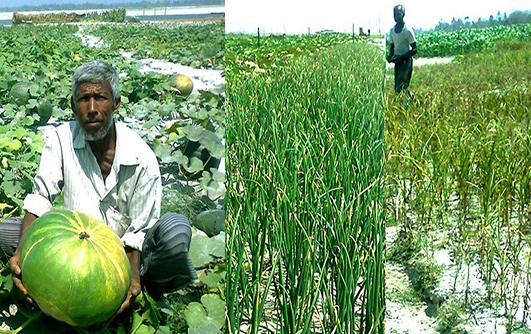RANGPUR, Mar 31, 2021 (BSS) – Expanded cultivation of various crops on char lands is effectively cutting poverty and improving livelihoods of many char people living in char areas of Rangpur agriculture region.
Officials of the Department of Agricultural Extension (DAE) and different NGOs said harvest of cultivated crops on shoals, silted-up riverbeds and char lands continues in full swing and will end before the commencement of the next rainy season.
The poor and landless char and riverside people have brought around one-lakh hectares of char lands in around 350 char villages under farming of various crops in all five districts of the region during this Rabi season.
They have mostly cultivated pumpkin, mustard, watermelon, ‘kawn’, onion, garlic, chili, pulses, potatoes and other vegetables, maize, wheat, squash, gourd, capsicum, Boro rice, groundnut, banana and many other crops on these lands this season.
“Char people have already completed harvest of many varieties of crops as the process will continue till mid-May next,” said Additional Director of the DAE at its Rangpur regional office, Agriculturalist Khandker Abdul Wahed.
Braving natural disasters like floods and river erosion every year, many char and riverside villagers have achieved self-reliance by cultivating crops using intercropping methods on char lands in the last 12 years in the region.
“The DAE has put maximum efforts on ensuring best use of char lands through providing assistance and technologies to people living there to increase crop output for improving their livelihoods and attaining food security amid changing climate,” Wahed said.
Talking to BSS, Senior Coordinator (Agriculture and Environment) of RDRS Bangladesh Agriculturist Mamunur Rashid said crop cultivation on shoals, dried up riverbeds and char lands is expanding every year.
“Many char families, who are beneficiaries of different government organisations and NGOs, have cultivated crops on char lands and dried-up riverbeds of the Brahmaputra, Teesta, Dharla, Kartoa and other rivers across the region this season,” he said.
Around 48,000 char and riverside families have achieved self-reliance by farming various crops on these lands improving their livelihoods and living standard with support of the DAE and different NGOs in the last 12 years in the region, Rashid added.
Talking to BSS, Abdur Razzaque, Morsheda Begum, Mahbub Alam and Kochhim Uddin of village Paschim Mohipur on the Teesta riverbank in Gangachara upazila in Rangpur said they have won poverty by cultivating various crops on char lands.
“By cultivating pumpkins with other crops on one acre of char lands adopting intercropping methods on the Teesta riverbed, I am expecting to earn a net profit of Taka one lakh after completing harvest by mid-May this year,” said Razzaque.
Similarly, Abdul Aziz of village Char Dakshin Kharibari in Nilphamari, Nur Islam of village Korpura in Kurigram, Moktar Ali and Maloti Rani of village Char Taluk Shahbaz in Rangpur narrated success stories of farming crops on char lands to change fortunes.
Maloti Rani said she has cultivated pumpkins by planting 180 saplings on sandy char lands on the Teesta riverbed spending Taka 80,000 this season.
“I have already started harvesting pumpkins with an average weight between two to seven kg each,” she said, adding that she is expecting to earn a net profit of Taka 2.50-lakh this season.



